|
|
 |
Fiche d'espèce de Copépode |
|
|
Calanoida ( Ordre ) |
|
|
|
Diaptomoidea ( Superfamille ) |
|
|
|
Pontellidae ( Famille ) |
|
|
|
Labidocera ( Genre ) |
|
|
| |
Labidocera kröyeri (Brady, 1883) (F,M) | |
| | | | | | | Syn.: | Pontella krøyeri Brady, 1883 (p.93, figs.F,M);
No Labidocera kröyeri similis (F) : Wolfenden, 1905 (1906) (p.1016, figs.F);
no Labidocera kroyeri : Sewell, 1914 a (p.233, 234: Rem.);
Labidocera kröyeri bidens Sewell, 1912 (p.369, fig.F, Rem.); Silas, 1972 (p.650); Silas & Pillai, 1973 (1976) (p.809);
No Labidocera kröyeri burmanica Sewell, 1912 (p.369, figs.M, Rem.); Silas, 1972 (p.650) | | | | Ref.: | | | Giesbrecht, 1892 (p.446, 459, 776, figs.F,M); Giesbrecht & Schmeil, 1898 (p.135, Rem. F,M); Thompson & Scott, 1903 (p.235, 251); A. Scott, 1909 (p.165, Rem.); Sewell, 1912 (p.353, 369, Rem.M); 1932 (p.362, Rem.); 1933 (p.28); Dakin & Colefax, 1933 (p.206); Rose, 1933 a (p.263, figs.F,M); Mori, 1937 (1964) (p.93, figs.M); C.B. Wilson, 1950 (p.246: part.); Krishnaswamy, 1953 (Rem.: p.131-133); Voronina, 1962 a (p.68); Tanaka, 1964 c (p.255, figs.F,M); Chen & Zhang, 1965 (p.100, figs.F,M); Fleminger, 1965 (p.124: Rem.); Saraswathy, 1966 (1967) (p.83, figs.F, Rem.); Goswami & Goswami, 1974 (p.109, fig.: caryotypes); Silas & Pillai, 1973 (1976) (p.809, Rem.); Greenwood, 1979 (p.99, figs.M,F, Rem.); Fleminger & al., 1982 (p.254, Rem.); Ohtsuka & Onbé, 1991 (p.214); Chihara & Murano, 1997 (p.867, Pl.148,151: F,M); Bradford-Grieve, 1999 b (p.194, figs.F,M, figs.184, 194); Mulyadi, 2002 (p.65, figs.F,M, Rem.); Conway & al., 2003 (p.129, figs.F,M, Rem.).; Vives & Shmeleva, 2007 (p.501, figs.F,M, Rem.); Jeong & al., 2009 (p.515, Rev.F,M, figs.F,M, distribution chart); Al-Yamani & al., 2011 (p.68, figs.F,M) | 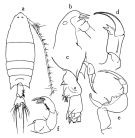 issued from : O. Tanaka in Publs Seto Mar. Biol. Lab., 1964, XII (3). [p.256, Fig.232]. Female: a, habitus (dorsal); b, forehead (right lateral side); c, last thoracic segment and urosome (left lateral side); d, P5. Male: e, rght P5; f, left P5. Nota: The urosome segments and furca are in the proportional lengths as 25:18:25:7:5:18 = 100. The head has lateral hooks. The lateral process of the last thoracic segment bifurcate at the apex.
|
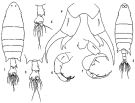 issued from: Q.-c Chen & S.-z. Zhang in Studia Marina Sinica, 1965, 7. [Pl.42, 1-7]. Female (from E China Sea): 1, habitus (dorsal); 2, urosome (another specimen), dorsal; 3, urosome (another specimen), dorsal; 4, P5 (posterior). Male: 5, habitus (dorsal); 6, left P5 (posterior); 7, right P5 (posterior).
|
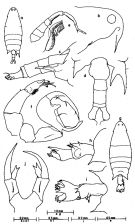 issued from : J.G. Greenwood in Proc. R. Soc. Qd, 1979, 90. [p.100, Fig.3]. Female (from Moreton Bay, E Australia): g, habitus (dorsal); h, corner of last thoracic segment and urosome (lateral right side); i, posterior part of last thoracic segment and urosome (dorsal); J, P5. Male: a, habitus (dorsal); b, forehead (lateral); c, posterior part of thoracic segment and urosome (lateral right side); d, idem (dorsal); e, right A1, with detail of denticular ridge on segment 18; f, P5. Nota: Little variation in females by contrast with Saraswathy's (1967) findings of considerable variation in urosomal armature in this species in Indian seas. In some cases the conical prominence on right mid-lateral surface of genital segment terminates as a small nipple, in others as one or parallel pair of small rods.; single spine dorsally on segment; paired spines posteriorly from right and dorsal posterior margin; either no spine or very small spine from left posterodorsal margin. Bases of caudal rami always covered by flat dorsal shield-like extension of 2nd urosomel segment, this shield terminating as single spine on right side, paired spine on left side, andtriplet of spines on postero-dorsal extension.
|
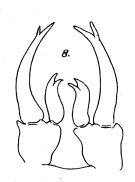 Issued from : R.B.S. Sewell in Rec. Indian Mus., 1912, 7. [Pl.XXIV, Fig.8]. As Labidocera krøyeri var. bidens. Female (from Bay of Bengal): 8, P5. Nota: A single female prsented a variation from the normal in the structure of exopod with a bifid appearance on the left side.
|
 Issued from : W. Giesbrecht in Systematik und Faunistik der Pelagischen Copepoden des Golfes von Neapel und der angrenzenden Meeres-Abschnitte. – Fauna Flora Golf. Neapel, 1892. Atlas von 54 Tafeln. [Taf.25, Fig.30]. Female: 30, P5. B1 = coxaa; B2 = basis; Re = exopod; Ri = endopod.
|
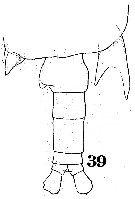 Issued from : W. Giesbrecht in Systematik und Faunistik der Pelagischen Copepoden des Golfes von Neapel und der angrenzenden Meeres-Abschnitte. – Fauna Flora Golf. Neapel, 1892. Atlas von 54 Tafeln. [Taf.41, Fig.39]. Male: 39, Th5 and urosome (dorsal).
|
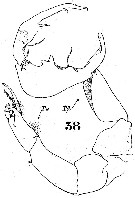 Issued from : W. Giesbrecht in Systematik und Faunistik der Pelagischen Copepoden des Golfes von Neapel und der angrenzenden Meeres-Abschnitte. – Fauna Flora Golf. Neapel, 1892. Atlas von 54 Tafeln. [Taf.23, Fig.38]. Male: 38, P5 (anterior view).
|
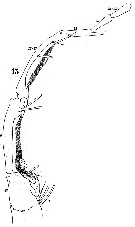 Issued from : W. Giesbrecht in Systematik und Faunistik der Pelagischen Copepoden des Golfes von Neapel und der angrenzenden Meeres-Abschnitte. – Fauna Flora Golf. Neapel, 1892. Atlas von 54 Tafeln. [Taf.23, Fig.13]. Male: 13, A1 (distal part, ventral view).
|
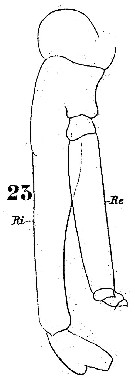 Issued from : W. Giesbrecht in Systematik und Faunistik der Pelagischen Copepoden des Golfes von Neapel und der angrenzenden Meeres-Abschnitte. – Fauna Flora Golf. Neapel, 1892. Atlas von 54 Tafeln. [Taf.23, Fig.23]. Male: 23, A2 (anterior view, setae missing).
|
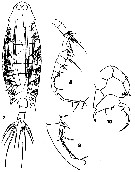 issued from : T. Mori in The pelagic Copepoda from the neighbouring waters of Japan, 1937 (2nd edit., 1964). [Pl.42, Figs.7-10]. Male: 7, habitus (dorsal); 8, right A1; 9, grasping segments of right A1; 10, P5.
|
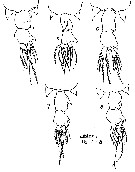 issued from : M. Saraswathy in Proc. Symp. Crustacea.- Symp. Ser. mar. biol. Ass. India, 1966, 2 (1). [p.82, Fig.1 (4-8)]. Female (from Trivandrum coast, SW India): 4-8, last thoracic segment and urosome of 5 specimens.
|
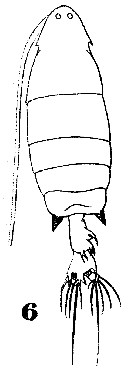 Issued from : W. Giesbrecht in Systematik und Faunistik der Pelagischen Copepoden des Golfes von Neapel und der angrenzenden Meeres-Abschnitte. - Fauna Flora Golf. Neapel, 1892. Atlas von 54 Tafeln. [Taf.41 , Fig. 6]. Female: habitus (dorsal).
|
 Issued from : W. Giesbrecht in Systematik und Faunistik der Pelagischen Copepoden des Golfes von Neapel und der angrenzenden Meeres-Abschnitte. – Fauna Flora Golf. Neapel, 1892. Atlas von 54 Tafeln. [Taf.41, Fig.11]. Female: 11, urosome (ventral).
|
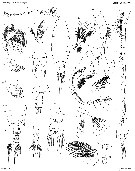 Issued from : G.S. Brady in Rep. Scient. Results Voy. Challenger, Zool., 1883, 8 (23). [Pl. XXXIX]. As Pontella kröyeri. Female: 1, habitus (dorsal); 2, A1; 5, A2; 6, Md; 7, Mx1; 8, Mx2; 9, Mxp; 10, P5; 14, posterior thoracic segments and urosome (ventral aspect); 15, same (lateral aspect); 16-17, urosome (others specimens). Male: 3, right A1; 4, portion of teeth (more highly magnified); 11, P5; 12, terminal papillae of P5 (left side); 13 the same of another specimen; 18, urosome (seen laterally); 19 same (seen from front).
|
 issued from : Y. Al-Yamani, V. Skryabin, A. Gubanova, S. khvorov & I. Prusova in Marine Zooplankton Prarctical Guide for the Northwestern Arabian Gulf, 2, 2011 [p.69, Fig.196, c, e]. Female (from Kuwait): c, urosome (dorsal); e, P5.
|
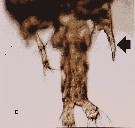 issued from : Y. Al-Yamani, V. Skryabin, A. Gubanova, S. khvorov & I. Prusova in Marine Zooplankton Prarctical Guide for the Northwestern Arabian Gulf, 2, 2011 [p.69, Fig.197 c]; Male: c, last pedigerous somite and urosome (dorsal). Arrow indicates right corner.
|
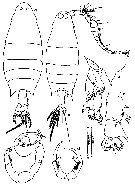 issued from : Mulyadi in Treubia, 2002, 32; [p.66, Fig.20]. Female (from Java): a, habitus (dorsal); b, metasomal somite 5 and urosome (lateral); c, urosome (ventral); d, P5. Male: e, habitus (dorsal); f, P5.
|
 issued from : Mulyadi in Treubia, 2002, 32; [p.59, Table 2]. Characteristics features of L. kroyeri in Indo-West Pacific. Comparison with L. detruncata, L. minuta and L. pectinata (see at these species).
|
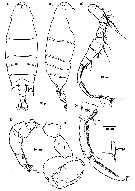 Issued from : H.G. Jeong, H.-L. Suh, S.B. Jeong, Y.H. Yoon & H.Y. Soh in Zoological Studies, 48 (4). [p.516, Fig.7]. Male (from 34°16'N, 127°34'E): A-B, habitus (dorsal and lateral, respectively); C, right A1; D, ancestral segments XIX-XXIV of right A1; E, P5 (L = left leg; R = right leg). Nota: Right A1 geniculate, indistinctly 14-segmented, ancestral segments II-IV, XV and XVI, XXI-XXIII completely fused; V-IX and X-XIV incompletely fused, with suture lines visible. Distal segment of left P5 with 2 tuberculated papillae.
| | | | | Ref. compl.: | | | Pearson, 1906 (p.30); Carl, 1907 (p.17); Sewell, 1948 (p.324, 473); Yamazi, 1958 (p.152, Rem.); Ganapati & Shanthakumari, 1962 (p.9, 15); Anraku & Azeta, 1965 (p.13, Table 2, fish predator); Mazza, 1966 (p.72); Brodsky, 1972 (p.256); Grice & Gibson, 1978 (p.23, tab.8); Kovalev & Shmeleva, 1982 (p.85); Madhupratap & Haridas, 1986 (p.105, 112: Rem., tab.1); Othman & al., 1990 (p.561, 564, Table 1); Hirakawa & al., 1990 (tab.3); Shih & Young, 1995 (p.72); Sharaf & Al-Ghais, 1997 (tab.1); Mauchline, 1998 (tab.8); El-Serehy, 1999 (p.172, Table 1, occurrence); Dalal & Goswami, 2001 (p.22, fig.2); Holmes, 2001 (p.31); Razai & al., 2004 (p.489, tab.2); Zuo & al., 2006 (p.163: tab.1); Hwang & al., 2006 (p.943, tabl. I); Dur & al., 2007 (p.197, Table IV, as L. kroeyeri); Humphrey, 2008 (p.84: Appendix A); Kâ & Hwang, 2011 (p.155, Table 3: occurrence %); Maiphae & Sa-ardrit, 2011 (p.641, Table 2, 3, Rem.); DiBacco & al., 2012 (p.483, Table S1, ballast water transport); Tachibana & al., 2013 (p.545, Table 1, seasonal change 2006-2008) | | | | NZ: | 5 + 2 douteuses | | |
|
Carte de distribution de Labidocera kröyeri par zones géographiques
|
| | | | | | | | | | | | | Loc: | | | ? W Ireland (Valentia Island), Liverpool Bay (in Giesbrecht & Schmeil, 1898; Pearson, 1906), ? Medit. (Malta), Arabian Sea, Arabian Gulf, UAE coast, Kuwait, Madagascar, Indian, India (W, Lawson Bay) Tavoy River, Kurau River, Burma, Straits of Malacca, G. of Thailand, Indonesia (Sunda Strait, Jakarta Bay, S Java, Ambon Bay, NE Celebes), Philippines (Sibago Is.), Viet-Nam (Cauda Bay), Gulf of Tonkin, Hong Kong, China Seas (East China Sea, South China Sea), Taiwan (SW, NE, Danshuei Estuary), S Korea, Japan, Nagazaki, Tokyo Bay, Tanabe Bay, Australia (E & SE, G. of Carpentaria)
Type locality: Arafura Sea. | | | | N: | 57 | | | | Lg.: | | | (46) F: 2,5-2,4; M: 2,05-1,95; (91) M: 2,14; (120) F: 2,75; M: 2,36-2,13; (290) F: 2,15-2,65; M: 2,05-2,15; (471) F: 2,53; M: 2,07; (530) F: 2,5-2; M: 2,5-2; (991) F: 2,4-2,5; M: 1,05-2,14; (1026) M: 2,1-2,16; (1085) F: 2,2-2,75; M: 2,0-2,35; (1087) F: 1,9-2,1; M: 1,6-1,7; {F: 1,90-2,75; M: 1,05-2,36} | | | | Rem.: | épipélagique.
Pour Fleminger (1965, p.124) les déterminations de C.B. Wilson (1950) dans le Pacifique Est sont erronées.
Sa présence est aussi très douteuse en Atlantique N et en Méditerranée.
L'espèce semble présenter une grande variabilité (notamment du 5ème segment thoracique).
Voir aussi les remarques en anglais | | | Dernière mise à jour : 19/07/2021 | |
|
|
 Toute utilisation de ce site pour une publication sera mentionnée avec la référence suivante : Toute utilisation de ce site pour une publication sera mentionnée avec la référence suivante :
Razouls C., Desreumaux N., Kouwenberg J. et de Bovée F., 2005-2025. - Biodiversité des Copépodes planctoniques marins (morphologie, répartition géographique et données biologiques). Sorbonne Université, CNRS. Disponible sur http://copepodes.obs-banyuls.fr [Accédé le 03 juillet 2025] © copyright 2005-2025 Sorbonne Université, CNRS
|
|
 |
 |






















